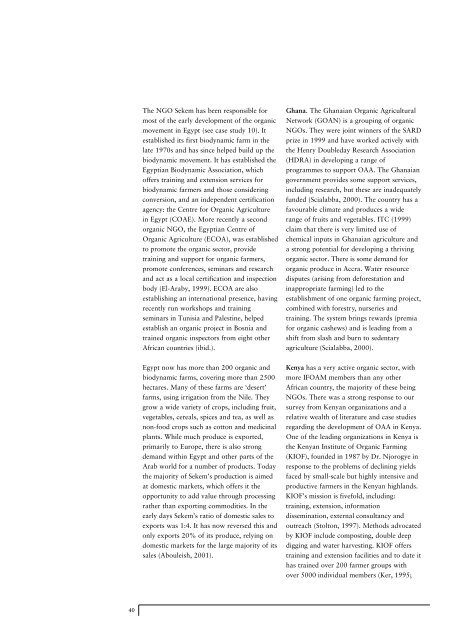The Real Green Revolution - Greenpeace UK
The Real Green Revolution - Greenpeace UK
The Real Green Revolution - Greenpeace UK
You also want an ePaper? Increase the reach of your titles
YUMPU automatically turns print PDFs into web optimized ePapers that Google loves.
<strong>The</strong> NGO Sekem has been responsible for<br />
most of the early development of the organic<br />
movement in Egypt (see case study 10). It<br />
established its first biodynamic farm in the<br />
late 1970s and has since helped build up the<br />
biodynamic movement. It has established the<br />
Egyptian Biodynamic Association, which<br />
offers training and extension services for<br />
biodynamic farmers and those considering<br />
conversion, and an independent certification<br />
agency: the Centre for Organic Agriculture<br />
in Egypt (COAE). More recently a second<br />
organic NGO, the Egyptian Centre of<br />
Organic Agriculture (ECOA), was established<br />
to promote the organic sector, provide<br />
training and support for organic farmers,<br />
promote conferences, seminars and research<br />
and act as a local certification and inspection<br />
body (El-Araby, 1999). ECOA are also<br />
establishing an international presence, having<br />
recently run workshops and training<br />
seminars in Tunisia and Palestine, helped<br />
establish an organic project in Bosnia and<br />
trained organic inspectors from eight other<br />
African countries (ibid.).<br />
Egypt now has more than 200 organic and<br />
biodynamic farms, covering more than 2500<br />
hectares. Many of these farms are ‘desert’<br />
farms, using irrigation from the Nile. <strong>The</strong>y<br />
grow a wide variety of crops, including fruit,<br />
vegetables, cereals, spices and tea, as well as<br />
non-food crops such as cotton and medicinal<br />
plants. While much produce is exported,<br />
primarily to Europe, there is also strong<br />
demand within Egypt and other parts of the<br />
Arab world for a number of products. Today<br />
the majority of Sekem’s production is aimed<br />
at domestic markets, which offers it the<br />
opportunity to add value through processing<br />
rather than exporting commodities. In the<br />
early days Sekem’s ratio of domestic sales to<br />
exports was 1:4. It has now reversed this and<br />
only exports 20% of its produce, relying on<br />
domestic markets for the large majority of its<br />
sales (Abouleish, 2001).<br />
Ghana. <strong>The</strong> Ghanaian Organic Agricultural<br />
Network (GOAN) is a grouping of organic<br />
NGOs. <strong>The</strong>y were joint winners of the SARD<br />
prize in 1999 and have worked actively with<br />
the Henry Doubleday Research Association<br />
(HDRA) in developing a range of<br />
programmes to support OAA. <strong>The</strong> Ghanaian<br />
government provides some support services,<br />
including research, but these are inadequately<br />
funded (Scialabba, 2000). <strong>The</strong> country has a<br />
favourable climate and produces a wide<br />
range of fruits and vegetables. ITC (1999)<br />
claim that there is very limited use of<br />
chemical inputs in Ghanaian agriculture and<br />
a strong potential for developing a thriving<br />
organic sector. <strong>The</strong>re is some demand for<br />
organic produce in Accra. Water resource<br />
disputes (arising from deforestation and<br />
inappropriate farming) led to the<br />
establishment of one organic farming project,<br />
combined with forestry, nurseries and<br />
training. <strong>The</strong> system brings rewards (premia<br />
for organic cashews) and is leading from a<br />
shift from slash and burn to sedentary<br />
agriculture (Scialabba, 2000).<br />
Kenya has a very active organic sector, with<br />
more IFOAM members than any other<br />
African country, the majority of these being<br />
NGOs. <strong>The</strong>re was a strong response to our<br />
survey from Kenyan organizations and a<br />
relative wealth of literature and case studies<br />
regarding the development of OAA in Kenya.<br />
One of the leading organizations in Kenya is<br />
the Kenyan Institute of Organic Farming<br />
(KIOF), founded in 1987 by Dr. Njorogye in<br />
response to the problems of declining yields<br />
faced by small-scale but highly intensive and<br />
productive farmers in the Kenyan highlands.<br />
KIOF’s mission is fivefold, including:<br />
training, extension, information<br />
dissemination, external consultancy and<br />
outreach (Stolton, 1997). Methods advocated<br />
by KIOF include composting, double deep<br />
digging and water harvesting. KIOF offers<br />
training and extension facilities and to date it<br />
has trained over 200 farmer groups with<br />
over 5000 individual members (Ker, 1995;<br />
40




![[2007] EWHC 311 - Greenpeace UK](https://img.yumpu.com/22079793/1/184x260/2007-ewhc-311-greenpeace-uk.jpg?quality=85)












